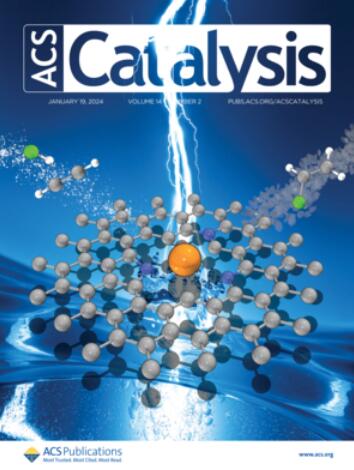Asymmetric Chiral Photocatalysts
IF 11.3
1区 化学
Q1 CHEMISTRY, PHYSICAL
引用次数: 0
Abstract
Traditional photocatalysts generally have a limitation of weak photoresponsiveness. Although current modification methods can improve light absorption and photoresponsiveness by increasing the surface area and optimizing the bandgap width, the vast majority of visible light has not been effectively utilized. Inorganic chiral photocatalysts can be synthesized using chiral solvents, additives, or templates as inducers. For nonpure phase inorganic chiral photocatalysts, their three-dimensional chiral nematic structure can be used to selectively reflect circularly polarized light, thereby reducing light energy loss and improving the photocatalyst’s light absorption capacity. It is worth noting that the photoactivity of these materials is not dependent on the specific chiral orientation of the structure. For pure phase inorganic chiral photocatalysts, the chirality index and radius would affect the band gap of the photocatalyst. Therefore, by adjusting these parameters, the band structure can be optimized to utilize more visible light, thereby improving the light absorption capacity. Compared to traditional thermal or electrocatalysis, asymmetric photocatalytic reactions offer two distinct advantages: (1) using light as an energy source can reduce dependence on fossil fuels and help achieve a more environmentally friendly and energy-efficient process; (2) photocatalytic reactions, operating through excited-state processes, can achieve transformations that are difficult or impossible to realize through conventional thermal or electrocatalytic methods. Therefore, the development of efficient asymmetric photocatalysts is a core requirement in the field of asymmetric photocatalysis. In contrast, single and dual functional chiral photocatalysts integrate visible light excitation and stereo control in the same catalyst, allowing the induced free radical intermediates to be placed in a chiral configuration. The introduction of chiral structures facilitates the rational design of photocatalytic systems, enabling precise control over the catalytic activity and selectivity. This review delves into the role of chiral ligands in regulating the conformational, electronic, and spatial structures during catalytic reactions, providing important insights for designing catalysts with higher activity and selectivity. Additionally, it summarizes the relationship between chiral ligands and catalytic reaction mechanisms, offering the potential to uncover key steps and reaction kinetics in the catalytic processes. This could provide a more systematic theoretical framework for the precise design of catalysts, thus promoting the widespread industrial application of asymmetric catalytic reactions.

不对称手性光催化剂
传统的光催化剂普遍存在光响应性弱的局限性。虽然目前的改性方法可以通过增加比表面积和优化带隙宽度来改善光吸收和光响应性,但绝大多数可见光并没有得到有效利用。无机手性光催化剂可以用手性溶剂、添加剂或模板作为诱导剂合成。对于非纯相无机手性光催化剂,可以利用其三维手性向列结构选择性反射圆偏振光,从而减少光能量损失,提高光催化剂的光吸收能力。值得注意的是,这些材料的光活性不依赖于结构的特定手性取向。对于纯相无机手性光催化剂,手性指数和半径会影响光催化剂的带隙。因此,通过调整这些参数,可以优化波段结构以利用更多的可见光,从而提高光吸收能力。与传统的热催化或电催化相比,不对称光催化反应具有两个明显的优势:(1)使用光作为能源可以减少对化石燃料的依赖,并有助于实现更环保和节能的过程;(2)光催化反应通过激发态过程进行,可以实现传统热催化或电催化方法难以或不可能实现的转化。因此,开发高效的不对称光催化剂是不对称光催化领域的核心要求。相比之下,单功能和双功能手性光催化剂在同一催化剂中集成了可见光激发和立体控制,允许诱导自由基中间体置于手性构型中。手性结构的引入促进了光催化体系的合理设计,实现了对催化活性和选择性的精确控制。本文综述了手性配体在催化反应中对构象、电子和空间结构的调节作用,为设计具有更高活性和选择性的催化剂提供了重要的见解。此外,总结了手性配体与催化反应机制之间的关系,为揭示催化过程中的关键步骤和反应动力学提供了可能。这可以为催化剂的精确设计提供更系统的理论框架,从而促进不对称催化反应的广泛工业应用。
本文章由计算机程序翻译,如有差异,请以英文原文为准。
求助全文
约1分钟内获得全文
求助全文
来源期刊

ACS Catalysis
CHEMISTRY, PHYSICAL-
CiteScore
20.80
自引率
6.20%
发文量
1253
审稿时长
1.5 months
期刊介绍:
ACS Catalysis is an esteemed journal that publishes original research in the fields of heterogeneous catalysis, molecular catalysis, and biocatalysis. It offers broad coverage across diverse areas such as life sciences, organometallics and synthesis, photochemistry and electrochemistry, drug discovery and synthesis, materials science, environmental protection, polymer discovery and synthesis, and energy and fuels.
The scope of the journal is to showcase innovative work in various aspects of catalysis. This includes new reactions and novel synthetic approaches utilizing known catalysts, the discovery or modification of new catalysts, elucidation of catalytic mechanisms through cutting-edge investigations, practical enhancements of existing processes, as well as conceptual advances in the field. Contributions to ACS Catalysis can encompass both experimental and theoretical research focused on catalytic molecules, macromolecules, and materials that exhibit catalytic turnover.
 求助内容:
求助内容: 应助结果提醒方式:
应助结果提醒方式:


